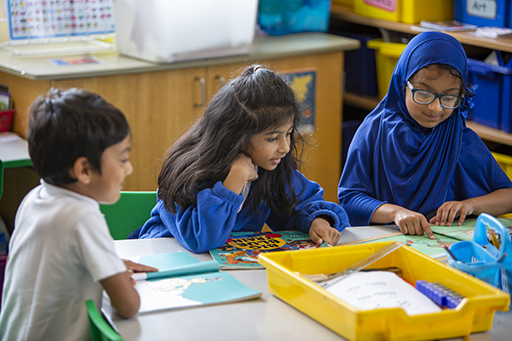9 Monitoring the impact of RfP pedagogy
As in all other areas of the curriculum, when teachers introduce new RfP pedagogic strategies, careful documentation of the impact on young readers is essential. Ensuring children’s voices and views are listened to from the outset is also important. For example, teachers can gather children’s views of reading time, their previous experiences and attitudes towards this, alongside other adults’ perspectives. Combining children’s and staff voices with observational notes over several sessions, alongside analysis of the young people’s discussions on what makes a ‘a good reader’ for instance, will help to establish a baseline and a reference point following the reshaping of provision.

This guidance document on children’s RfP [Tip: hold Ctrl and click a link to open it in a new tab. (Hide tip)] offers strategies to help you notice and track the impact of your renewed RfP pedagogy. Working through this document is not part of the allotted time for the course, but nonetheless you may find it useful to peruse, save and return to later. By using a mixture of tools that always includes observation, you can reflect on shifts in the ways children position themselves as readers over time.
If teachers merely change their provision and hope this will have the desired impact, this is likely to reinforce the ‘Matthew effect’ whereby good readers benefit the most from interventions (Stanovich, 1986), and less assured readers are caught in a circle of disadvantage. Instead, a focus on disaffected readers is important as these ‘can but don’t’ readers (Moss, 2000), are often not intrinsically motivated and may seek to avoid reading. Some may be ‘RfP disadvantaged’ and some may see reading as a chore. Altering this perspective, if it has been ingrained over many years, will be a challenging process.
In order to support less engaged readers, teachers need to attend to subtle shifts in their attitudes, behaviours and identities. To do so it is valuable to notice, document, reflect and act.
Activity 4 Taking action to support less engaged readers
Read the teachers’ documentation and initial reflective questions below. Then decide what action you might take to support the child, either immediately or later. All the children are able to read at their grade level, but almost never choose to do so, at school or at home.
Lucy, aged 6 years old. It’s reading aloud time. Lucy seems to be listening, her head directed towards Mr B, but when they’re invited to predict in pairs what will happen to the mouse, she turns slowly towards Farrah, lets her share her views and just shrugs in response. They sit in silence for a few moments before Mr B starts reading again. Is Lucy listening or taking a break? How can I help?
Ellis, aged 8 years old. It’s free choice time and most unusually he’s not gone to the maths table but to our core text box and taken Ruby’s Worry by Tom Percival which I read aloud yesterday. He has settled near Gus (who also has a copy) and appears to be reading it aloud, his intonation is similar to mine. How can I capitalise upon this?
Aafiya, aged 10 years old. It’s library time and he’s chatting to Cassius about the football. When reprimanded, he looks at the display, selects Dahl’s The Witches and walks slowly to a spare chair, looking around all the while (for friends?). After a few minutes he goes back, whispering something to Cassius and grabs a Horrible Histories magazine. What can I do to support him?
Comment
Each act of noticing affords the educator an opportunity to reflect and act, but it is important to note there is never only one right response. Each action taken needs to be thoughtfully evaluated and its impact on the child tracked. For instance, the teacher might go to join Ellis who is re-reading the class read-aloud to himself and explore what he likes about the book. Equally they might ask Ellis if he’d like to take the book home, or borrow another Tom Percival book. Much will depend on their wider knowledge of Ellis and his interests.
Ongoing monitoring and evaluation of the impact of RfP pedagogy enables teachers to respond to individual readers and to flexibly and subtly shift their practice to ensure that, as effectively as possible, it motivates all the children and draws them into the classroom community of readers.

